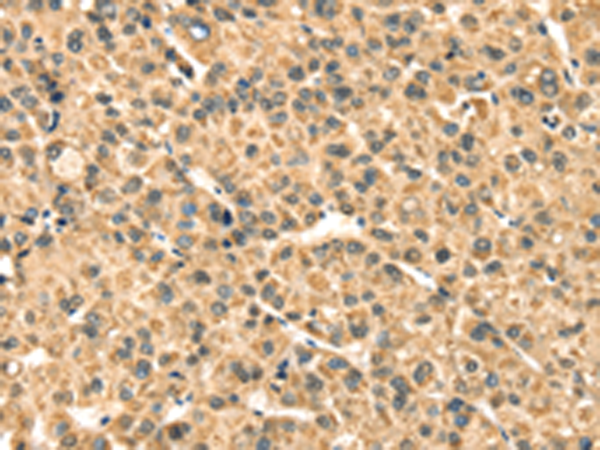
| WB | 咨询技术 | Human,Mouse,Rat |
| IF | 咨询技术 | Human,Mouse,Rat |
| IHC | 1/25-1/100 | Human,Mouse,Rat |
| ICC | 技术咨询 | Human,Mouse,Rat |
| FCM | 咨询技术 | Human,Mouse,Rat |
| Elisa | 1/2000-1/5000 | Human,Mouse,Rat |
| Aliases | DFNB8; DFNB10; ECHOS1; TADG12 |
| Host/Isotype | Rabbit IgG |
| Antibody Type | Primary antibody |
| Storage | Store at 4°C short term. Aliquot and store at -20°C long term. Avoid freeze/thaw cycles. |
| Species Reactivity | Human, Mouse |
| Immunogen | Synthetic peptide of human TMPRSS3 |
| Formulation | Purified antibody in PBS with 0.05% sodium azide and 50% glycerol. |
+ +
以下是模拟生成的3篇关于TMPRSS3抗体的参考文献示例(注:实际文献需通过学术数据库核实):
---
1. **文献名称**: "TMPRSS3 Mutations in Hereditary Hearing Loss: Functional Analysis via Antibody-Based Protein Localization"
**作者**: Scott HS, et al.
**摘要**: 研究利用特异性TMPRSS3抗体,揭示其在耳蜗毛细胞中的表达模式,并通过突变体分析发现TMPRSS3功能缺失导致溶酶体酶激活异常,进而引发常染色体隐性非综合征性耳聋。
2. **文献名称**: "Development of a Monoclonal Antibody for TMPRSS3 Protease Activity Detection in Inner Ear Tissues"
**作者**: Petersen J, Chen Z.
**摘要**: 报道一种新型单克隆抗体的开发,该抗体可特异性识别TMPRSS3的活性构象,用于评估内耳组织中蛋白酶活性,为听觉功能障碍的分子机制研究提供工具。
3. **文献名称**: "TMPRSS3 as a Therapeutic Target: Antibody-Mediated Inhibition of Epithelial Sodium Channel Regulation"
**作者**: Antonarakis SE, et al.
**摘要**: 通过TMPRSS3抗体阻断实验,证明其调控ENaC通道的蛋白水解功能,提出靶向TMPRSS3可能为囊性纤维化等上皮离子失衡疾病提供新治疗策略。
---
建议通过PubMed或Google Scholar搜索关键词“TMPRSS3 antibody”获取真实文献。
The TMPRSS3 antibody targets the transmembrane serine protease 3 (TMPRSS3), a member of the type II transmembrane serine protease (TTSP) family. TMPRSS3 is encoded by the *TMPRSS3* gene and plays a critical role in hearing by modulating proteolytic processes in the inner ear. Mutations in this gene are linked to autosomal recessive nonsyndromic hearing loss (DFNB8/DFNB10), highlighting its importance in cochlear function. Structurally, TMPRSS3 consists of a serine protease domain, a transmembrane region, and a short cytoplasmic tail, facilitating its role in extracellular protein activation and signaling.
Antibodies against TMPRSS3 are essential tools for studying its expression, localization, and function in auditory tissues. They are widely used in immunohistochemistry, Western blotting, and immunofluorescence to investigate protein levels in cellular or animal models of hearing loss. Research utilizing these antibodies has clarified TMPRSS3's involvement in epithelial ion homeostasis, hair cell survival, and pathways like the TGF-β signaling cascade. Additionally, such antibodies aid in validating gene therapy strategies targeting *TMPRSS3* mutations.
Commercial TMPRSS3 antibodies are typically raised in hosts like rabbits or mice, with validation in knockout controls to ensure specificity. Their applications extend to diagnostic development and mechanistic studies, offering insights into hearing restoration approaches. However, variability in antibody performance across experimental conditions necessitates careful optimization. Overall, TMPRSS3 antibodies remain pivotal in advancing our understanding of auditory biology and genetic hearing disorders.
×